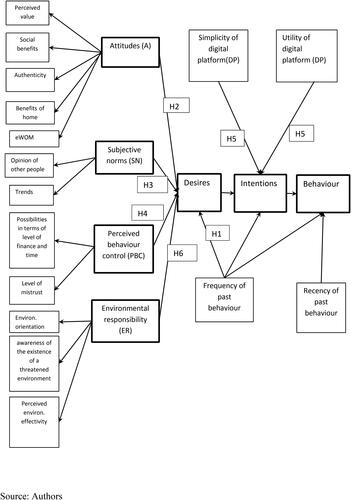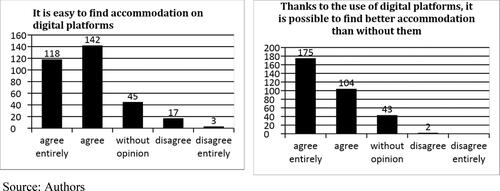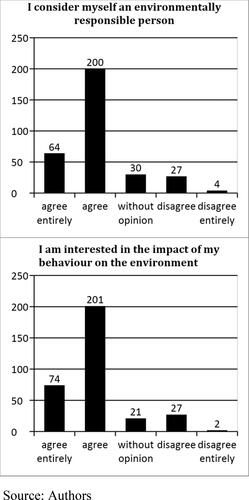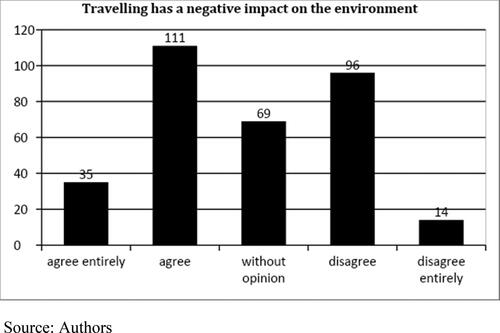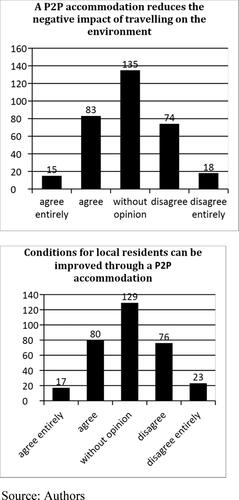Abstract
Our paper aimed to identify key factors affecting the use of peer to peer accommodation through the generation of millennials. The analysis of customer behaviour was based on a goal-oriented behavioural model (MGB) which was enlarged by the environmental responsibility and the impact of digital platforms. According to the findings of structural modelling, important influences on the desire to use a peer to peer (P2P) accommodation included the millennial generation’s attitudes towards social benefits and previous authentic experiences. The interesting finding is that environmental aspects alone were not a sufficient motivator to increase millennials’ desire to use a P2P accommodation.
1. Introduction
In recent years, peer to peer (P2P) accommodation has expanded not only within the global economy (PricewaterhouseCoopers, Citation2015) but also within the Czech Republic, where the growing trend of using this type of accommodation has become increasingly prominent (Airbnb, Citation2019a). Besides, it is noteworthy that the market share of accommodation for Airbnb in the Czech Republic accounts for only 5–6% of the overall accommodation market (Johnson, Citation2017), which indicates significant unused capacity and the possibility for growth in the future. The popularity of the P2P economy has been generally growing, which is largely attributed to the phenomenon of the millennials, who Silver (Citation2015) describes as a group of people born between 1980 and 2000. Typical for this group is the movement from owning property to accessing it and the subsequent experiences emerging from this. These young people want to share their experiences (Olson & Kemp, Citation2015), learn about new cultures, and gather new experiences (Nelson, Citation2013), while insisting on their values and comfort (Thompson & Weissmann, Citation2012). They avoid consumption and seek more sustainable solutions which match their own values. Rebell (Citation2015) demonstrated that the P2P economy, including accommodation, has thus become an integral part of millennials’ lives, a generation that accounts for more than 60% of those involved in P2P accommodation. This led us to examine the attitudes of the main group of customers towards this form of P2P accommodation, and what they deemed more important. The objective of the paper is to analyse customer behaviour and identify the key factors in the decision-making of Czech millennials within a specific sector of the P2P economy – i.e. accommodation.
2. Theoretical background
This analysis of customer behaviour is based on a model of goal-behavioural model (MGB) (Perugini & Bagozzi, Citation2001). The reason why MGB was chosen because unlike TPB (Theory of planned behaviour), it is better at explaining the gap between customer intention and actual behaviour (Perugini & Bagozzi, Citation2001; Han et al., Citation2016). The MGB model is illustrated in .
Figure 1. The MGB model.
Source: Perugini and Bagozzi (Citation2001).
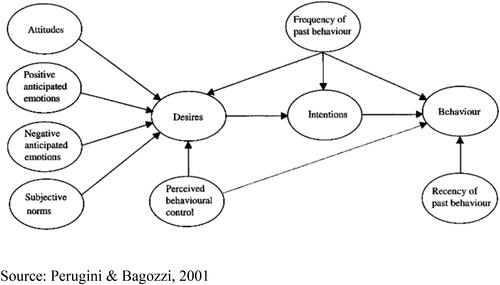
MGB model was previously used in customer behaviour research linked to travel and accommodation by Han et al. (Citation2014) and Song et al. (Citation2012). Arguments for the suitability of this model are based on the newly identified predictor of interest or desire (Bagozzi & Dholakia, Citation2006).
As evidenced in , the MGB model also looks at the customer’s behaviour in the past, which shows that the more often an individual behaves in a certain way in the past, the more likely they will behave in a similar manner in the future. As a result, their behaviour will eventually become a habit (PWC, Citation2015; Wood & Neal, Citation2007). According to the authors of MGB, the influence of past behaviour manifests both in the frequency of past behaviour and in its recent history (Perugini & Bagozzi, Citation2001). These arguments allow us to outline the hypothesis:
H1: Millennials past behaviour has a positive effect on desire to use P2P accommodation. Until now, this model has never been used to examine particular groups of millennials with their specific features and characteristics.
2.1. MGB model from the perspective of the millennial generation
MGB model comprises of four main areas: customer attitudes, subjective norms, and perceived behavioural control. Following Cherry (Citation2018), we understand customer attitudes as a learned tendency to evaluate people, issues, objects, and events in a positive, negative or neutral way. Generally, customer attitudes are viewed through perceived values, social benefits, the authenticity of experiences, and benefit of home (Guttentag, Citation2015; Guttentag et al., Citation2018; Mao & Lyu, Citation2017; Pesonen & Tussyadiah, Citation2016; So et al., Citation2018; Tussyadiah, Citation2016). Perceived values such as better quality for low prices, are key for the competitiveness of P2P accommodation and for many of its users (Mao & Lyu, Citation2017; Pesonen & Tussyadiah, Citation2016). Meanwhile social benefits such as social interaction and learning about new cultures have a positive effect on the intention to use P2P accommodation. (Guttentag et al., Citation2018; Tussyadiah, Citation2016; So et al., Citation2018) The authenticity of experiences as an accurate picture of the visited country and experiencing the typical life of the local people influences the relationship between the customer´s attitudes and their intention to use P2P accommodation positively (Pesonen & Tussyadiah, Citation2016). The same relationship is shared between the benefits of home as facilities in the accommodation and the feeling of home and spaciousness as costumers' attitudes and the intention to use P2P accommodation. (Guttentag, Citation2015; So et al., Citation2018; Tussyadiah, Citation2016). On the basis of these arguments, we define our second hypothesis.
H2: Millennials’ attitudes have a positive effect on their desire to use P2P accommodation.
In our research, subjective norms are observed using ideas and trends which are important, acceptable by the society, as well as workable (Amaro et al., Citation2018; Lee et al., Citation2012; Mao & Lyu, Citation2017; Perugini & Bagozzi, Citation2001). Kim and Jang (Citation2014) refer to subjective norms as the customer’s decision that is affected by social and interpersonal pressure. The individual’s opinion based on what other people think also assumes importance and forecasts their intention to behave in a certain way (Wang, Citation2017). Moreover, latest studies (Amaro et al., Citation2018; Mao & Lyu, Citation2017) suggest that subjective norms have a positive impact on the desire to use P2P accommodation. Accordingly, we define the third hypothesis.
H3: Subjective norms of millennials have a positive effect on the desire to use P2P accommodation.
Within our research model, perceived behavioural control is examined based on the required financial and time costs, as well as understanding the manner in which a P2P accommodation operates (Mao & Lyu, Citation2017; Song et al., Citation2012). Additionally, Mao and Lyu (2017) explicate the level of mistrust that is explored through the concept of perceived risk and uncertainty (Quintal et al., Citation2010). This, in turn, affects the desire to use P2P accommodation. These assertions lead to the definition of the fourth hypothesis:
H4: Perceived behavioural control of millennials has a positive effect on the desire to use P2P accommodation.
The group of millennials can be characterized by the way they use the tools and platforms for online purchases. Hamstra (Citation2018) argues that digital platforms and online shopping are popular because they help save time and money, bring comfort to their users, ensure nonstop accessibility of services, provide unlimited information, and create opportunities for immediate comparisons. These platforms are attributed to constant innovations, which lead to much higher user-friendliness, which is very popular among millennials (Mishra & Olshavsky, Citation2005). The constant phase of development increases people’s trust in digital platforms and reduces uncertainty as well as the risk of making a wrong choice (Godelnik, Citation2017). This led us to consider whether or not the use of digital platforms has a motivational effect on customers in terms of using P2P accommodation. Tussyadiah (Citation2016) examined this issue in a similar way when she discovered that the use of P2P digital platforms has a motivational effect on the concept of the P2P economy in terms of customer behaviour (Davis, Citation1986; Lai, Citation2017). The basic model tests two variables – perceived utility and perceived ease of use. The perceived utility is defined as the subjective expectation of the user that using the system improves performance. On the other hand, perceived ease of use relates to the level at which a potential user expects that the technology can be used without any difficulty (Davis, Citation1986). Perceived utility and perceived ease of use of P2P platforms could be a crucial motivational factor for millennials, because the majority of them (97%) is familiar with the online environment. In comparison to other age groups, they are also the largest consumer base (Statista.com, Citation2018). As part of the research, this aspect is examined by determining the intention to use P2P accommodation. These arguments lead us to define another hypothesis:
H5: Using digital platforms have a positive effect on the intention of millennials to use P2P accommodation.
Another indispensable of decision-making and travel is communication by word of mouth (WOM) (Berezan et al., Citation2015; Litvin et al., Citation2008), which can be viewed as eWOM in the online environment (Granitz & Ward, Citation1996) and which the customer perceives as being more reliable than advertising (Allsop et al., 2007). In the online world, this primarily includes reviews, discussion forums and messages that spread rapidly through social networks, where the public reviews of products and services are viewed as the best (Schindler & Bickart, Citation2005). In addition to avoiding paid advertising, the generation of millennials takes into account information acquired from online reviews by evaluation of products and services (Mangold & Smith, Citation2012; Woo, Citation2018). Social networks also enable them to share their experiences with P2P platforms (John, Citation2013). Therefore, this aspect has been added to consumer attitudes towards P2P accommodation.
Extant research into P2P accommodation mentions another level that is associated with this form of accommodation – consumer environmental responsibility (Botsman & Rogers, Citation2010; Salvioni, Citation2016). This is justified by the lower consumption of water and energy, less frequent use of cleaning chemicals, and recycling of waste (Airbnb, Citation2019c). In comparison with hotel facilities, P2P platforms support the emergence of a sustainable market (Phipps et al., Citation2013). Further research also demonstrates the increased efficiency in using accommodation capacity due to the reduction in fixed costs, which makes it possible to provide this type of accommodation at a reduced price (Salvioni, Citation2016). Huang et al. (Citation2014) understands the environmental dimension on three levels – the environmental attitudes of millennials, their awareness of the existence of a threatened environment and their perception of P2P accommodation as being environmentally friendly. The desire or interest in using P2P accommodation is then monitored in terms of these factors. One notable characteristic of the millennial generation is their focus on social and environmental issues (Silver, Citation2015), as well as their outlook for the future (Naderi & Steenburg, Citation2018). These findings lead us to define the last hypothesis:
H6: Environmental responsibility of millennials has a positive effect on their desire to use P2P accommodation.
These aspects added to the MGB model are illustrated in and can help identify the main factors in the decision-making of the generation of Czech millennials in terms of P2P accommodation.
3. Methodology and sampling
The research included quantitative research using a questionnaire. The data acquired were analysed using structural equation modelling (SEM). The questionnaire consisted of forty open and closed questions. The respondents were expected to assess the closed questions based on a five -point Likert Scale (1 – agree entirely, 5 – disagree entirely).
The questions used in the questionnaire were created on the basis of the knowledge gained from the literature research. the recommendation of the authors of the MGB model, as well as on previous research relating to tourism.
3.1. Data collection
The questionnaires were distributed online through Facebook groups and direct contact with potential respondents who matched the characteristics of the groups of millennials. As part of the questionnaire, the respondents were asked if they were born between 1980 and 2000, in order to guarantee that it was exclusively a group of millennials. The data collection took place between 17 March and 31 March 2019. The sample was limited geographically on the Czech and Slovak millennials due to the language used in the questionnaire. Finally, 339 completed questionnaires were collected in totality. As part of the data cleaning process, 14 questionnaires had to be discarded due to responses that were incorrectly completed. Therefore, the final research sample numbered N = 325 respondents. Of those who completed the questionnaire survey, 72% were women and 28% were men. At the same time, 43% were millennials who were in full-time study, 29% were employed full-time work, 24% were employed part-time. The remaining respondents were either unemployed or on maternity leave (41% were Slovak) and (59% were Czech) millennials. There was also a sufficiently large sample of respondents who had not used P2P accommodation, which is why the research focused on the barriers which might prevent the use of P2P accommodation. Almost 32% of respondents used a P2P accommodation occasionally, 25% of respondents used it often or always, whereas 24% had not yet come across this form of accommodation. The remaining percentage corresponds to the type who often uses this type of accommodation.
3.2. Processing the data
The expanded MGB model was verified using structural modelling (SEM analysis), which is a common practice in other research studies (Ajzen, Citation1991; Cheng et al., Citation2006; Han et al., Citation2010; Lee et al., Citation2012; Mao & Lyu, Citation2017; Meng & Choi,Citation2016; Perugini & Bagozzi, Citation2001). Nevertheless, before commencing the use of SEM analysis, it was necessary to verify the basic suppositions which are detected through multidimensional outlier points, multiple internal correlations between the variables, as well as the normal data distribution (Kline, Citation2011). For this purpose, we used the Mahalanobis distance, Pearson’s correlation, and the Shapiro-Wilk test. Based on the recommendations of Anderson and Gerbing (Citation1988), a confirmatory factor analysis using the maximum likelihood method was used to evaluate the model identification and ascertain the accuracy of the latent constructs. After defining the main factors, the internal consistency of the data and the overall deviation of the defined constructs were verified using the Cronbach alpha. In the second step, structural modelling was used to test causal relationships (Meng & Choi, Citation2016). Finally, the suitability of the overall model was confirmed through goodness-of-fit statistics (Perugini & Bagozzi, Citation2001), whereas descriptive statistics were used if further information was to be added. The data from the questionnaire were processed using the SPSS Statistic 23 programme. The Amos software program was used for the SEM analysis.
3.3. Identifying and testing the model
At the start of testing the model’s measurements, factor analysis was carried out with proximal rotation, which did not confirm the configuration of the factors in an expected manner.Footnote1 As a result, explorative factor analysis was carried out to redefine the model, eliminating the variables which distorted the factor validity from the individual factors. The newly adjusted factors accounted for 59.2% of the total variance explained, owing to which the condition of achieving a level of at least 0.5% or more for this indicator was fulfilled (Hair et al., Citation2006; Mao & Lyu, Citation2017). Subsequently, the internal consistency of the data was evaluated using Cronbach’s alpha.
For the individual factors presented in , the value of Cronbach’s alpha was between 0.7 and 0.9, indicating an acceptable level of reliability for each of the latent constructs (Hair et al., Citation2010; Mao & Lyu, Citation2017).
Table 1. Standardized regressive weights and Cronbach’s alpha constructs.
Following this adjustment, a confirmatory factor analysis (CFA) was carried out to confirm or refute the re-established latent variables along with their measurability using the variables observed. The results, measured using the indicators CMIN/df, NFI CFI and RMSEA, confirm that the proposed constructs indicate adequate agreement with the data. illustrates the values of the results in the mutual correlation between the latent constructs as well as the influence of the individual variables on individual factors.
Figure 3. Results of the confirmation factor analysis.
Source: Authors from the AMOS programme.
Note. The goodness-of-fit statistics and a comparison with the recommended values according to Meng and Choi (Citation2016): CMIN/df = 1.302 (<0.3), NFI = 0.956 (>0.90), CFI = 0.989 (>0.90), RMSEA = 0.031 (<0.08).
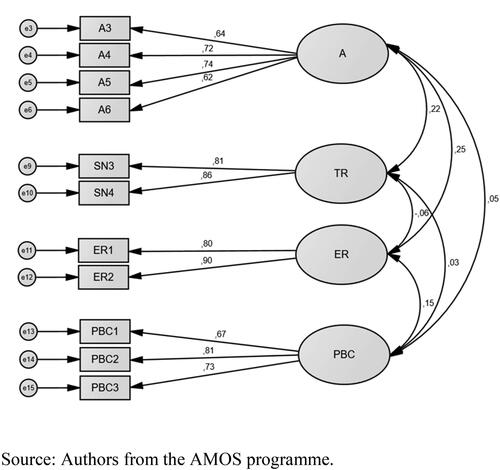
The results of the goodness-of-fit statistics demonstrate an adequate alignment of latent constructs, which is in accordance with the data. The next step is then to test the structural model.
3.4. Testing and comparing structural models
Before evaluating the results from testing the structural model, four versions of the final model were compared using goodness-of-fit statistics in order to evaluate the suitability of the models for the research, as presented in Table 5. The models under comparison were the MGB model, which were expanded to include environmental responsibility (ER) and digital platforms (DP1 and DP2). Thereafter, the MGB model expanded only to include the influence of ER, or only the influence of DP, and the original unenlarged model.
The resulting indicators presented in , confirm the fact that each of the proposed structural models would adequately correspond with the collected data, apart from the NFI indicator, where the value for both models remains the same. According to the findings, the best match is with the model that is only expanded by the environmental responsibility of the millennials on the desire to use P2P accommodation.
Table 2. Comparing the suitability of the original MGB model and its expansion.
Even though the study will no longer focus on the model expanded by the influence of digital platforms, it is interesting to mention some findings. The influence of DP1 and DP2 was assessed based on perceiving the simplicity and utility of digital platforms through the questions: “I can easily find accommodation on digital platforms for P2P accommodation, and Thanks to using digital platforms I can find better accommodation than without them.” The SEM analysis did not reveal the statistical significance of this influence on the intention of millennials to use P2P accommodation. This finding is quite surprising because more than 80% of millennials stated that they consider digital platforms offering P2P accommodation as simple and useful. Despite the questionnaire results illustrated in below, the assertion by Venkatesh and Davis (Citation1996) was not confirmed that the perceived utility and simplicity of the technology have a positive influence on the individual’s intention to behave in a certain way.
4. Results
Based on goodness-of-fit statistics, the model which was expanded to include the influence of the millennials’ environmental responsibility could adequately predict and explain the desire/intention of millennials to use a P2P accommodation. Importantly, with regard to the H1 to H6 that form 12 of the relationships analysed between the predictors and explanatory variables, eight of them were evaluated as statistically significant on the basis of a standardized regression coefficient.
below shows that attitudes (ßp=0.22), current trends (ßtr=0.21) and frequency of past behaviour (ßf-t=0.49) positively affect the desire of millennials to use P2P accommodation. The frequency of past behaviour also has a statistically significant positive influence on the intention of millennials (ßf-z=0,36) and their actual use of P2P accommodation (ßf-z=0,63). Similarly, it has a statistically significant positive influence on the use of P2P accommodation and the recent use of this form. (ßf-z=0,32).
Figure 5. Structural model and coefficients.
Note. The interrupted lines illustrate the statistically insignificant relationships where p > 0.05.
Source: Authors.
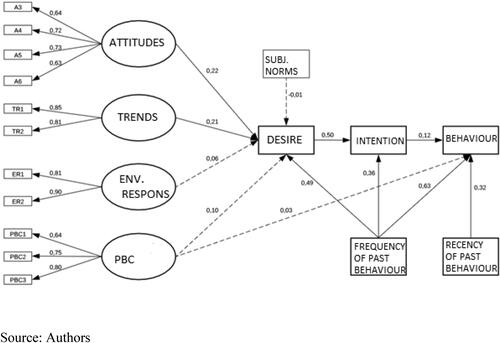
The most significant influence on the desire of millennials to use P2P accommodation is the frequency of past behaviour RQ1 (ßf-t=0,49) corresponding to the assertion by Wood and Neal (Citation2007), PWC (Citation2015), that the more frequently a person behaves in a certain way in the past, the stronger their likelihood to repeat this behaviour. The results also underline the importance of the influence of millennials’ desire on their actual intention to behave in this manner (ßd=0,50). In case of the indirect effect of desire on actual behaviour, which can be characterized as a mediator (intention in our case), where part of the causal effect is assumed to shift from the previous variable to the next one (Kline, Citation2011), the size of this indirect influence was found to be at the level of 0.062.
For predictors of attitudes (H2) and trends (H3), it is possible to identify significance at the level (attitude ßp=0.22, trends ßtr=0.21), which positively influences millennials’ desire to use a P2P accommodation. In this case, it can be stated that perceived value (Venkatesh et al., Citation2012), social benefits (Guttentag et al., Citation2018), authenticity (Guttentag et al., 2018; Pesonen & Tussyadiah, Citation2016) and benefits of the home (Guttentag, Citation2015; So et al., Citation2018) have a positive influence on the desire of millennials to actually use P2P accommodation, thus also confirming the conclusions of the aforementioned researchers. The influence of trends has a similar effect on the positive influence on the desire to use a P2P accommodation, which is consistent with the findings of Kim and Jang (Citation2014).
As with the influence of millennials’ environmental responsibility, the influence of perceived behavioural control on desire and the actual behaviour of millennials can be judged to be statistically insignificant in terms of H4 and H6. The statistically insignificant influence of perceived behavioural control corresponds to the results obtained by Mao and Lyu (Citation2017) and Song et al. (Citation2012). In the millennials’ relationship with environmental responsibility, it was interesting to take a closer look at the statistically insignificant environmental responsibility during the strategic analyses. This is attributed to the fact that various sources (Huang et al., Citation2014; Luchs et al., Citation2011; So et al., Citation2018) have shown that the popularity of a P2P accommodation relates to its long-term sustainability with greater respect for the environment and the local community.
As evidenced in , the millennials’ answers to their environmental attitudes demonstrate that approximately 81% of them consider themselves to be environmentally responsible and more than 84% are interested in the impact of their behaviour on the environment. However, the SEM analysis showed that environmental attitudes alone were not a sufficient motivator to increase millennials’ desire to use a P2P accommodation.
The results are not so unambiguous in terms of the awareness of damaging the environment by travelling. As seen in , only less than 50% of those asked perceive travelling as an activity which causes damage to the environment. Another 34% do not share this impression and disagree that travelling has a negative impact on the environment.
As shown in , the final area under investigation as part of environmental responsibility was perceived effectiveness of a P2P accommodation in two areas. The first was in reducing the negative impact on the environment, whereas the second one was about enhancing the living conditions for local inhabitants. Interestingly, approximately 40% of millennials were unable to judge the effectiveness of a P2P accommodation in terms of the environment and the local community. An additional 30% took a negative position on these claims.
5. Discussion
Although the presented results were observed also from individual culture (Czech and Slovak), no significant results were found. This can be attributed to the fact that that a lot of millennials are students of universities and live in very close proximity to each other. There are a lot of Czech students who know the Slovak culture and the language in as well as their Slovak counterparts, thus emphasizing the closeness of their cultures. In the area of consumer behaviour these two cultures are very similar (Krbová, Citation2016) and the importance of individual culture in our research is not also crucial. This also explains why we decided to present the results without considering the individual culture of these two group of millennials.
On the other hand, the importance of customer attitudes has been proved by many researchers (Cheng et al., Citation2006; Mao & Lyu, Citation2017). In our research, customer attitudes such as social benefit and authenticity of experiences are the most important predictors of the desire to use P2P accommodation. These findings are in line with the researches of Guttentag et al. (Citation2018), Pesonen and Tussyadiah (Citation2016), Mao and Lyu (Citation2017). Other confirmed findings are connected with the benefits of home (So et al., Citation2018; Tussyadiah, Citation2016) e.g. availability of the kitchen, dishwasher, etc. that also assume great importance for young millennials.
The research is also oriented on perceived value of P2P accommodation and as well as on previous works (Guttentag, Citation2015; Mao & Lyu, Citation2017; Pesonen & Tussyadiah, Citation2016; So et al., Citation2018; Tussyadiah, Citation2016). Our research has confirmed that millennials perceive the P2P accommodation as economic effective and using P2P accommodation they expect the good quality with the good price.
Despite the research studies of Mao and Lyu (Citation2017), Kim and Jang (Citation2014), Amaro et al. (Citation2018), Wang (Citation2017), our findings have not proved the importance of subjective norms on customer behaviour when using P2P accommodation. This could be caused by the observed group of millennials, which is far more open to new experiences, focused on cooperation with a comparison with older generations (Olson & Kemp, Citation2015).
Our other results concerning the perceived control of behaviour are in line with the findings of Mao and Lyu (Citation2017) and Song et al. (Citation2012). This is attributed to the fact that millennials compare the P2P accommodation with the common type of accommodation. Another reason can be seen in the level of using a digital platform, which is extremely high within the generation of millennials, in combination with high differentiation of P2P accommodation. Following Mao and Lyu (Citation2017) and Godelnik (Citation2017), the aforementioned factors mentioned make the ideal conditions for the decision of using P2P form of accommodation.
Last but not the least, the confirmed finding following Silver (Citation2015) is the interest of millennials in environmental affairs, through the impact of their behaviour on the environment. Although the P2P form of accommodation is deemed sustainable, our findings have not proved the significance of environmental responsibility. One of the reasons for this can be the lack of communication focused on the environmental benefit of P2P accommodation.
6. Conclusion, limitations and practical implication
The results from structural modelling showed that for a group of millennials, i.e. people born between 1989 and 2000, the most significant motivator for using a P2P accommodation is past experience with the concept under research. Other important influences on the desire to use a P2P accommodation included their attitudes towards social benefits and authentic experiences. One new finding was the significant influence of current trends, which evidently makes it clear to millennials that by using P2P accommodation, they are following current trends and are being fashionable.
An interesting finding was that surrounding pressures represented by trends on the generation under investigation did not play a significant role in their decision-making. Similarly, the perceived behavioural control and the use of digital platforms was found to have an insignificant impact on the millennial generation, since the generation considers it as a necessary condition for the concept to work rather than a motivator. Environmental responsibility also has a similarly insignificant influence with regard to the desire of using P2P accommodation, despite the fact that more than 80% of millennials perceive themselves as environmentally aware and are interested in the impact of their behaviour on the environment. The most significant problem was the low level for perceiving P2P accommodation as lowering the negative impact of traveling on the environment.
The research has practical implications on the providers of P2P accommodation. Providers should try to diminish the level of mistrust and the fear of unknown culture as well as people by strengthening the safe authenticity e.g. in form of higher privacy or the peaceful form of social interaction with local culture and people.Virtual seeing of the flat and the video presentation of the host and their hobbies may be very efficacious in augmenting the interest of the P2P accommodation and challenge the fear from the unknown. Even now, the Airbnb gains from the offer of adventures and experiences on their websites, which implies that the closer contact with the guests would help attract more guests. We also recommend focusing on presenting the environmental effectivity of P2P form of accommodation. In order to enhance the environmental aspect of P2P accommodation, it may be convenient to add the stated evaluation system of the accommodation of another factor e.g. environmental responsibility of host concerning for example recycling, the possibility to use the bicycle, sorting of waste, etc. This could be also advantageous for the hotelkeepers that have to challenge the increasing competition of the P2P platform of accommodation. Lot of hotelkeepers use the P2P platforms to offer their rooms. Built a new business model based on environmental sustainability, authentic experiences and social benefits can be the new way how to tackle the current competition.
Given that the competition in P2P accommodation is still increasing, focusing on our suggestions could help enhance the competitive advantage of hosts and hotelkeepers.
Despite the very interesting findings, it is necessary to mention the limitations of this research. The first of these is that the data did not fulfil the condition for normal distribution, which is widely acknowledged as one of the basic prerequisites of the SEM analysis. Nevertheless, we do not consider the study with the original data to be a fundamental obstacle to the outputs presented owing to the sufficiently large sample and the fact that similar results were obtained after a logarithmic transformation of the data. Another limitation is the fact that the P2P accommodation was assessed in a uniform manner for all of the digital platforms offering this type of accommodation. Naturally, some of the sources mention the differences between the individual platforms. Therefore, in subsequent studies, it would be appropriate to verify the results from each of the platforms separately.
Disclosure statement
No potential conflict of interest was reported by the authors.
Notes
1 The indicators for the influence of digital platforms (DP1 and DP2), past behaviour (PBf and PBr), subjective norms (SN1) and also the indicators of desire (D), intention (I) and behaviour (B) were excluded from testing the model’s measurements as they are only made up of one indicator.
References
- Airbnb. (2019a). Fast facts. https://press.airbnb.com/fast-facts/
- Airbnb. (2019b). The Airbnb community in the Czech Republic. https://2sqy5r1jf93u30kwzc1smfqt-wpengine.netdna-ssl.com/wpcontent/uploads/2017/10/Czech-Republic-EIS-Sept-2017.pdf
- Airbnb. (2019c). A greener way to travel: The environmental impacts of home sharing. https://blog.atairbnb.com/environmental-impacts-of-homesharing/
- Ajzen, I. (1991). The theory of planned behavior. Organizational Behavior and Human Decision Processes, 50(2), 179–211. https://doi.org/https://doi.org/10.1016/0749-5978(91)90020-T
- Allsop, D. T., Bassett, B. R., & Hoskins, J. A. (2007). Word-of-mouth research: Principles and applications. Journal of Advertising Research, 47(4), 398–411. https://doi.org/https://doi.org/10.2501/S0021849907070419
- Amaro, S., Andreu, L., & Huang, S. (2018). Millenials’ intentions to book on Airbnb. https://www.tandfonline.com/doi/pdf/10.1080/13683500.2018.1448368?needAccess=true
- Anderson, J. C., & Gerbing, D. W. (1988). Structural equation modelling in practice: A review and recommended two-step approach. Psychological Bulletin, 103(3), 411–423. https://doi.org/https://doi.org/10.1037/0033-2909.103.3.411
- Bagozzi, R. P., & Dholakia, U. M. (2006). Antecedents and purchase consequences of customer participation in small group brand communities. International Journal of Research in Marketing, 23(1), 45–61. https://doi.org/https://doi.org/10.1016/j.ijresmar.2006.01.005
- Berezan, O., Raab, C., Tanford, S., & Kim, Y.-S. (2015). Evaluating loyalty constructs among hotel reward program members using eWOM. Journal of Hospitality & Tourism Research, 39(2), 198–224. https://doi.org/https://doi.org/10.1177/1096348012471384
- Botsman, R., & Rogers, R. (2010). What’s mine is yours: The rise of collaborative consumption. Harper Collins.
- Cheng, S., Lam, T., & Hsu, C. (2006). Negative word-of-mouth communication intention: An application of the theory of planned behavior. Journal of Hospitality & Tourism Research, 30(1), 95–116.
- Cherry, K. (2018). Attitudes and behavior in psychology. https://www.verywellmind.com/attitudes-how-they-form-change-shape-behavior2795897
- Davis, F. D. (1986). A technology acceptance model for empirically testing new end-user information systems: Theory and results. Sloan School of Management, Massachusetts Institute of Technology.
- Godelnik, R. (2017). Millennials and the sharing economy: Lessons from a ‘buy nothing new, share everything month’ project. Environmental Innovation and Societal Transitions, 23, 40–52. https://doi.org/https://doi.org/10.1016/j.eist.2017.02.002
- Granitz, N. A., & Ward, J. C. (1996). Virtual community: A sociognitive analysis. In K. P. Corfman & J. G. Lynch (Eds.), Advances in consumer research (Vol. 23, pp. 163–166). Association for Consumer Research.
- Guttentag, D. (2015). Airbnb: Disruptive innovation and the rise of an informal tourism accommodation sector. Current Issues in Tourism, 18(12), 1192–1217. https://doi.org/https://doi.org/10.1080/13683500.2013.827159
- Guttentag, D., Smith, S., Potwarka, L., & Havitz, M. (2018). Why tourists choose Airbnb: A motivation-based segmentation study. Journal of Travel Research, 57(3), 342–359. https://doi.org/https://doi.org/10.1177/0047287517696980
- Hair, J. F., Babin, B. J., & Anderson, R. E. (2010). Multivariate data analysis. Prentice Hall.
- Hair, J. F., Black, W. C., Babin, B. J., Anderson, R. E., & Tatham, R. L. L. (2006). Multivariate data analysis. Pearson.
- Hamstra, M. (2018). Millennials see savings, convenience in online shopping: Survey. https://www.supermarketnews.com/consumer-trends/millennials-seesavings-convenience-online-shopping-survey
- Han, H., Jae, M., & Hwang, J. (2016). Cruise travellers’ environmentally responsible decision-making: An integrative framework of goal-directed behavior and norm activation process. International Journal of Hospitality Management, 53, 94–105. https://doi.org/https://doi.org/10.1016/j.ijhm.2015.12.005
- Han, H., Kim, W., & Hzun, S. S. (2014). Overseas travelers’ decision formation for airport shopping behavior. Journal of Travel & Tourism Marketing, 31(8), 985–1003.
- Han, H., Hsu, L. T. J., & Sheu, C. (2010). Application of the theory of panned behavior to green hotel choice: Testing the effect of environmentally friendly activities. Tourism Management, 31(3), 325–334. https://doi.org/https://doi.org/10.1016/j.tourman.2009.03.013
- Huang, H.-C., Lin, T.-H., Lai, M.-C., & Lin, T.-L. (2014). Environmental consciousness and green behavior: An examination of motivation crowding effect. International Journal of Hospitality Management, 40, 139–149. https://doi.org/https://doi.org/10.1016/j.ijhm.2014.04.006
- John, N. A. (2013). The social logics of sharing. The Communication Review, (3)16, 113–131. https://doi.org/https://doi.org/10.1080/10714421.2013.807119
- Johnson, C. (2017). Massive growth forecasts for Czech shared economy. https://www.radio.cz/en/section/business/massive-growth-forecast-for-czechshared-economy
- Kim, D., & Jang, S. (2014). Motivational drivers for status consumption: A study of generation Y consumers. International Journal of Hospitality Management, 38, 39–47. https://doi.org/https://doi.org/10.1016/j.ijhm.2013.12.003
- Kline, B. K. (2011). Principles and practice of structural equation modeling (3rd ed.). Guilford Press.
- Krbová, P. K. (2016). Generation Y attitudes towards shopping: A comparison of the Czech Republic and Slovakia. Journal of Competitiveness, 8(1).
- Lai, P. (2017). The literature review of technology adoption models and theories for the novelty technology. Journal of Information Systems and Technology Management, 14(1), 21–36. https://doi.org/https://doi.org/10.4301/S1807-17752017000100002
- Lee, C., Song, H., Bendle, L. J., Kim, M., & Han, H. (2012). The impact of nonpharmaceutical interventions for 2009 H1N1 influenza on travel intentions: A model of goal-directed behavior. Tourism Management, 33(1), 89–99. https://doi.org/https://doi.org/10.1016/j.tourman.2011.02.006
- Litvin, S. W., Goldsmith, R. E., & Pan, B. (2008). Electronic word-of-mouth in hospitality and tourism management. Tourism Management, 29(3), 458–468. https://doi.org/https://doi.org/10.1016/j.tourman.2007.05.011
- Luchs, M., Naylor, R. W., Rose, R. L., Catlin, J. R., Gau, R., Kapitan, S., Mish, J., Ozanne, L., Phipps, M., Simpson, B., Subrahmanyan, S., & Weaver, T. (2011). Toward a sustainable marketplace: Expanding options and benefits for consumers. Journal of Research for Consumers, 19, 1–12.
- Mangold, W. G., & Smith, K. T. (2012). Selling to Millennials with online reviews. Business Horizons, (2)55, 141–153. https://doi.org/https://doi.org/10.1016/j.bushor.2011.11.001
- Mao, Z., & Lyu, J. (2017). Why travelers use Airbnb again? International Journal of Contemporary Hospitality Management, 29(9), 2464–2482. https://doi.org/https://doi.org/10.1108/IJCHM-08-2016-0439
- Meng, B., & Choi, K. (2016). The role of authenticity in forming slow tourists´ intentions: Developing an extended model of goal-directed behavior. Tourism Management, 57, 397–410. https://doi.org/https://doi.org/10.1016/j.tourman.2016.07.003
- Mishra, S., & Olshavsky, R. W. (2005). Rationality unbounded: The internet and its effect on consumer decision making. In C. P. Haugtvedt, K. A. Machleit, & R. F. Yalch (Eds.), Online consumer psychology. Understanding and Influencing Consumer Behavior in the Virtual World (pp. 361–378). Routledge.
- Naderi, I., & Steenburg, E. V. (2018). Me first, then the environment: Young Millennials as green consumers. Young Consumers, 19(3), 280–295. https://doi.org/https://doi.org/10.1108/YC-08-2017-00722
- Nelson, N. (2013). Why Millennials are ditching cars and redefining ownership: NPR. https://www.npr.org/2013/08/21/209579037/why-millennialsare-ditching-cars-and-redefining-ownership?t=1542279675137
- Olson, M., Kemp, S. (2015). Sharing economy: An in-depth look at its evolution and trajectory across industries – Collaborative economy. Piper Jaffray. https://collaborativeeconomy.com/wp/wp-content/uploads/2015/04/SharingEconomy-An-In-Depth-Look-At-Its-Evolution-and-Trajectory-Across-Industries-.pdf
- Perugini, M., & Bagozzi, R. P. (2001). The role of desires and anticipated emotions in goal-directed behaviours: Broadening and deepening the theory of planned behaviour. The British Journal of Social Psychology, 40(Pt 1), 79–98. https://doi.org/https://doi.org/10.1348/014466601164704
- Pesonen, J. A., & Tussyadiah, I. (2016). Drivers and barriers of peer-to-peer accommodation stay – An exploratory study with American and Finnish travellers. Current Issues in Tourism, 21(6), 703–720.
- Phipps, M., Ozanne, L. K., Luchs, M. G., Subrahmanyan, S., Kapitan, S., Catlin, J. R., Gau, R., Naylor, R. W., Rose, R. L., Simpson, B., & Weaver, T. (2013). Understanding the inherent complexity of sustainable consumption: A social cognitive framework. Journal of Business Research, 66(8), 1227–1234. https://doi.org/https://doi.org/10.1016/j.jbusres.2012.08.016
- PricewaterhouseCoopers. (2015). The sharing economy: Consumer intelligence series. www.pwc.com/us/en/technology/publications/assets/pwc-consumerintelligence-series-the-sharing-economy.pdf
- PWC. (2015). The Sharing economy. Consumer intelligence series. https://www.pwc.com/us/en/technology/publications/assets/pwc-consumer-intelligenceseries-the-sharing-economy.pdf
- Quintal, V. A., Lee, J. A., & Soutar, G. N. (2010). Risk, uncertainty and the theory of planned behavior: A tourism example. Tourism Management, 31(6), 797–805. https://doi.org/https://doi.org/10.1016/j.tourman.2009.08.006
- Rebell, B. (2015). Millennials will outgrow the sharing economy. http://time.com/money/3957652/sharing-economy-millennials
- Salvioni, D. M. (2016). Hotel chains and the sharing economy in global tourism. Symphonya. Emerging Issues in Management, 1, 31–44.
- Schindler, R. M., & Bickart, B., (2005). Published word of mouth: Referable, consumer generated information on the internet. In C. P. Haugtvedt, K. A. Machleit, & R. F. Yalch, Online consumer psychology. Understanding and influencing consumer behavior in the virtual world (pp. 35–61). Routledge.
- Silver, A. J. (2015). The urban sharing economy: Entrepreneurship and equity in cities – Senior thesis for the Urban Studies Program. Columbia University.
- So, K. K. F., Oh, H., & Min, S. (2018). Motivations and constraints of Airbnb consumers: Findings from a mixed-methods approach. Tourism Management, 67, 224–236. https://doi.org/https://doi.org/10.1016/j.tourman.2018.01.009
- Song, H., J., Lee Ch, K., Kang, S., K., & Boo, S.-J. (2012). The effect of environmentally friendly perceptions on festival visitors’ decision-making process using an extended model of goal-directed behavior. Tourism Management, 33(6), 1417–1428. https://doi.org/https://doi.org/10.1016/j.tourman.2012.01.004
- Statista.com. (2018). U.S. Millennials: Internet usage and online shopping - Statistics & facts. https://www.statista.com/topics/2576/usmillennials-internet-usage-and-online-shopping/
- Thompson, D., & Weissmann, J. (2012). The cheapest generation. The Atlantic. https://www.theatlantic.com/magazine/archive/2012/09/thecheapest-generation/309060/
- Tussyadiah, I. P. (2016). Factors of satisfaction and intention to use peer-to-peer accommodation. International Journal of Hospitality Management, 55, 70–80. https://doi.org/https://doi.org/10.1016/j.ijhm.2016.03.005
- Venkatesh, V., & Davis, F. D. (1996). A model of the antecedents of perceived ease of use: Development and test. Decision Sciences, 27(3), 451–481. https://doi.org/https://doi.org/10.1111/j.1540-5915.1996.tb01822.x
- Venkatesh, V., Thong, J. Y., & Xu, X. (2012). Consumer acceptance and use of information technology: Extending the unified theory of acceptance and use of technology. MIS Quarterly, 36(1), 157–178. https://doi.org/https://doi.org/10.2307/41410412
- Wang, J. (2017). Perceptions of individual behavior in green event—From the theory of planned behavior perspective. American Journal of Industrial and Business Management, 07(08), 973–988. https://doi.org/https://doi.org/10.4236/ajibm.2017.78070
- Woo, A. (2018). Understanding the research on millennial shopping behaviors. https://www.forbes.com/sites/forbesagencycouncil/2018/06/04/understanding-theresearch-on-millennial-shopping-behaviors/#46b045535f7a
- Wood, W., & Neal, D. T. (2007). A new look at habits and the habit-goal interface. Psychological Review, 114(4), 843–863. https://doi.org/https://doi.org/10.1037/0033-295X.114.4.843

